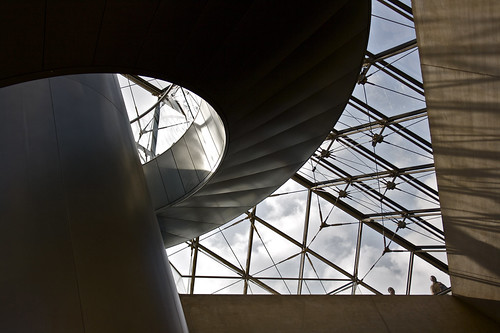Tag: Louvre
Inside the 666 Pyramid
It has been claimed by some that the glass panes in the Louvre Pyramid add up to exactly 666. , Dominique Stezepfandt’s book François Mitterrand, Grand Architecte de l’Univers declares that "the pyramid is dedicated to a power described as the Beast in the Book of Revelation. The entire structure is based on the number 6."
The story of the 666 panes originated in the 1980s, when the official brochure published during construction did indeed cite this number (even twice, though a few pages earlier the total number of panes was given as 672 instead). The number 666 was also mentioned in various newspapers. The Louvre museum however states that the finished pyramid contains 673 glass panes (603 rhombi and 70 triangles).
A higher figure was obtained by David A. Shugarts, who reports that the pyramid contains 689 pieces of glass. Shugarts obtained the figure from the offices of I.M. Pei. Various attempts to actually count the panes in the pyramid have produced slightly discrepant results, but there are definitely more than 666. A quick calculation based on 18 units per edge with two tiers removed in the center at the entrance easily confirms the 673 number.
The myth resurfaced in 2003, when Dan Brown incorporated it in his best-selling novel The Da Vinci Code. Here the protagonist reflects that "this pyramid, at President Mitterrand’s explicit demand, had been constructed of exactly 666 panes of glass – a bizarre request that had always been a hot topic among conspiracy buffs who claimed 666 was the number of Satan". However, David A. Shugarts reports that according to a spokeswoman of the offices of I.M. Pei, the French President never specified the number of panes to be used in the pyramid. Noting how the 666 rumor circulated in some French newspapers in the mid-1980s, she commented: "If you only found those old articles and didn’t do any deeper fact checking, and were extremely credulous, you might believe the 666 story".
The Grand Louvre
Louvre Palace (Palais du Louvre) which began as a fortress built in the late 12th century under Philip II. Remnants of the fortress are still visible. The building was extended many times to form the present Louvre Palace. In 1672, Louis XIV chose the Palace of Versailles for his household, leaving the Louvre primarily as a place to display the royal collection, including, from 1692, a collection of antique sculpture. In 1692, the building was occupied by the Académie des Inscriptions et Belles Lettres and the Académie Royale de Peinture et de Sculpture, which in 1699 held the first of a series of salons.
The Académie remained at the Louvre for 100 years. During the French Revolution, the National Assembly decreed that the Louvre should be used as a museum, to display the nation’s masterpieces.
The museum opened on 10 August 1793 with an exhibition of 537 paintings, the majority of the works being confiscated church and royal property. Because of structural problems with the building, the museum was closed in 1796 until 1801. The size of the collection increased under Napoleon when the museum was renamed the Musée Napoléon. After his defeat at Waterloo, many works seized by Napoleon’s armies were returned to their original owners. The collection was further increased during the reigns of Louis XVIII and Charles X, and during the Second French Empire the museum gained 20,000 pieces. Holdings have grown steadily through donations and gifts since the Third Republic, except during the two World Wars.
As of 2008, the collection is divided among eight curatorial departments: Egyptian Antiquities; Near Eastern Antiquities; Greek, Etruscan, and Roman Antiquities; Islamic Art; Sculpture; Decorative Arts; Paintings; Prints and Drawings.
The pyramid and the underground lobby beneath it were created because of a series of problems with the Louvre’s original main entrance, which could no longer handle an enormous number of visitors on an everyday basis. Visitors entering through the pyramid descend into the spacious lobby then re-ascend into the main Louvre buildings.


